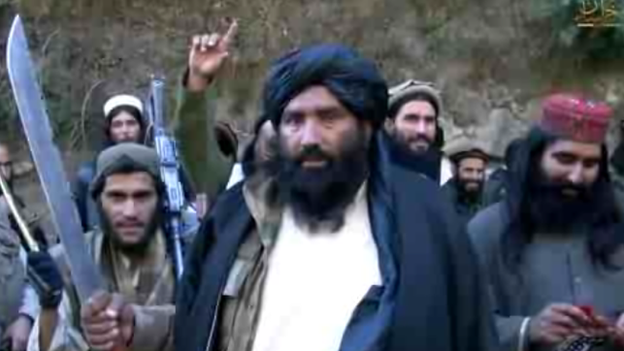Afghanistan drone strike 'kills IS commander Abdul Rauf'
- Published

This group of former Taliban fighters pledged allegiance to IS in Pakistan last month
A drone strike in Afghanistan has killed a militant commander who recently swore allegiance to Islamic State (IS), officials say.
The police chief of Helmand said that former Taliban commander Mullah Abdul Rauf had died in the Nato strike.
It emerged last month that Rauf had sworn allegiance to IS after falling out with the Taliban.
Tribal elders in northern Helmand say a car carrying up to six people was destroyed while crossing the desert.
The car was loaded with ammunition and exploded, reports said.

Analysis: BBC's David Loyn, Kabul
Analysts are divided over whether those flying black flags in Afghanistan are opportunists or are directed by the IS leadership in Syria and Iraq.
The commander killed in Helmand, Mullah Abdul Rauf, was appointed deputy commander in the region some weeks after he first declared his allegiance when he split from the Taliban.
The air strike that killed him was one of the first reported under Nato's new mandate.
There have been increasing reports of people supporting IS from across the country. Afghan government spokesmen continue to insist that they are disaffected Taliban, and not a significant new development.
One disturbing aspect is that the name used by IS in Syria to describe the offshoot here is the Khorasan group, using an old name for Afghanistan.
And there is an ancient myth that black flags will fly again in Khorasan shortly before the end of the world.

The Afghan Intelligence Agency also said Rauf had been killed. Nato confirmed the air strike, but not the intended target.
Afghan forces say it has been very hard to call in air strikes under the new Nato mandate since the beginning of this year. This was one of the first strikes to be approved.
The militant commander's brother-in-law and four Pakistanis were also killed in the attack, Helmand police chief Nabi Jan Mullahkhel was quoted by Reuters as saying.
Islamic State controls swathes of Syria and Iraq and has a small but growing presence in parts of Afghanistan.
Correspondents say it poses the first serious challenge to the coherence of the Taliban leadership for many years.

Where else is Islamic State active?
Egypt: Based in Sinai, the IS branch was essentially a re-branding of Ansar Beit al-Maqdis, which first emerged in 2011 in the wake of the Egyptian revolution.
Libya: Three distinct Libyan IS "provinces" were announced in November - Barqah in the east, Tripoli in the west and Fazzan in the south.
Algeria: A breakaway group from al-Qaeda's North Africa branch (AQIM), the IS branch rose to prominence in September when it beheaded French tourist Herve Gourdel. Since then it has been largely silent.
Yemen and Saudi Arabia: The new branches have not claimed any activities yet but the move represents a symbolic challenge to al-Qaeda.
Afghanistan-Pakistan: IS says its branch here represents the historic Khorasan Province - a region covering Afghanistan, Pakistan and "other nearby lands".

Rauf, who spent six years in Guantanamo Bay after being captured by US forces in 2001, was reported to have fallen out with the leader of the Taliban, Mullah Omar.
He swapped the white flags of the Taliban for the black flags of IS and recruited followers in Helmand.
Rauf was then named as deputy leader of IS in "Khorasan" - an old name for Afghanistan - by the organisation in Syria.
The most senior IS commander for the region is Saeed Khan, who is based in Orakzai tribal agency in Pakistan.
Correction 13 February: A picture appeared in this article which was captioned as Mullah Abdul Rauf. We no longer believe that this was Rauf and have removed it. We apologise for any distress caused by the photograph, which was supplied to the BBC by the Afghan National Directorate of Security.